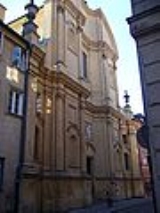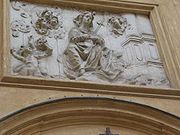
St Martin's Church, Warsaw
Encyclopedia
St. Martin's Church is a church in Warsaw
, Poland
. It is located on ulica Piwna ("Beer Street") in the Polish capital's Old Town
.
cloister and a hospital of the Holy Spirit
intra muros by Siemowit III
duke of Masovia and his wife Eufemia. In 1571 the famous Wojciech Oczko was made a hospital doctor. The church itself, which was a stone, gothic building, was erected at the turn of 14th and 15th century. Its entrance was located from the side of the town walls, not from Piwna street, as today. The temple had three altars: main altar of St. Martin and side altars of the Holy Ghost and of St. Dorothy.
 In the 17th century on the churchyard of Augustinians' Monastery was the place where sessions of local Mazovian parliament were organised. After some fires, which destroyed the church in 15th and 17th century, it was converted in baroque style by Giovanni Spinola from Italy. Also at that time the church was reoriented, the main entrance was located from Piwna Street and the altar was moved to south-western side (to the side of the town walls). In the 17th century, a good standard orchestra was maintained by the Augustinians, which performed in the church. Inside, Adam Jarzębski
In the 17th century on the churchyard of Augustinians' Monastery was the place where sessions of local Mazovian parliament were organised. After some fires, which destroyed the church in 15th and 17th century, it was converted in baroque style by Giovanni Spinola from Italy. Also at that time the church was reoriented, the main entrance was located from Piwna Street and the altar was moved to south-western side (to the side of the town walls). In the 17th century, a good standard orchestra was maintained by the Augustinians, which performed in the church. Inside, Adam Jarzębski
was buried, a musician and composer that worked for the kings of the Vasa Dynasty
.
The church was reconstructed in about 1744 according to Karol Bay's design, and resembles the architecture of Bay's Church of Order of the Visitation
. The main façade of waved lines represent so-called Melted Sugar style in the rococo
architecture. The central altar also according to Karol Bay's design with sculptures by Jan Jerzy Plersch was accomplished in 1751.
, although the interior is completely modern. The profuse early baroque furnishings, created in the 1630s by Jan Henel (sculptor of King Władysław IV Vasa
) together with the rococo decorations done in the 1750s, were destroyed by German bombing during the Warsaw Uprising
. The church was ruined. It was reconstructed after the World War II
. Inside the church, at the end of right nave a chapel of Our Lady of Consolation with a copy of a painting from 15th century and at the end of the left one - the chapel of Jesus Christ. Next to the sanctuary there is a chapel of St. Francis with the most valuable element of the church's furnishing - polychromed figure of the Virgin Mary with the Child.
Warsaw
Warsaw is the capital and largest city of Poland. It is located on the Vistula River, roughly from the Baltic Sea and from the Carpathian Mountains. Its population in 2010 was estimated at 1,716,855 residents with a greater metropolitan area of 2,631,902 residents, making Warsaw the 10th most...
, Poland
Poland
Poland , officially the Republic of Poland , is a country in Central Europe bordered by Germany to the west; the Czech Republic and Slovakia to the south; Ukraine, Belarus and Lithuania to the east; and the Baltic Sea and Kaliningrad Oblast, a Russian exclave, to the north...
. It is located on ulica Piwna ("Beer Street") in the Polish capital's Old Town
Warsaw Old Town
Warsaw's Old Town is the oldest historic district of the city. It is bounded by Wybrzeże Gdańskie, along the bank of the Vistula, and by Grodzka, Mostowa and Podwale Streets. It is one of Warsaw's most prominent tourist attractions....
.
History
It was established in 1353 together with the adjacent AugustiniansAugustinians
The term Augustinians, named after Saint Augustine of Hippo , applies to two separate and unrelated types of Catholic religious orders:...
cloister and a hospital of the Holy Spirit
Holy Spirit
Holy Spirit is a term introduced in English translations of the Hebrew Bible, but understood differently in the main Abrahamic religions.While the general concept of a "Spirit" that permeates the cosmos has been used in various religions Holy Spirit is a term introduced in English translations of...
intra muros by Siemowit III
Siemowit III of Masovia
Siemowit III of Masovia was a prince of Masovia and a co-regent of the lands of Warsaw, Czersk, Rawa, Gostynin and other parts of Masovia.- Life :...
duke of Masovia and his wife Eufemia. In 1571 the famous Wojciech Oczko was made a hospital doctor. The church itself, which was a stone, gothic building, was erected at the turn of 14th and 15th century. Its entrance was located from the side of the town walls, not from Piwna street, as today. The temple had three altars: main altar of St. Martin and side altars of the Holy Ghost and of St. Dorothy.

Adam Jarzebski
Adam Jarzębski was an early baroque Polish composer, violinist, poet, and writer. The first documented mention of Jarzębski was in 1612, when he became a member of the chapel of Johann Siegmund Hohenzollern in Berlin...
was buried, a musician and composer that worked for the kings of the Vasa Dynasty
House of Vasa
The House of Vasa was the Royal House of Sweden 1523-1654 and of Poland 1587-1668. It originated from a noble family in Uppland of which several members had high offices during the 15th century....
.
The church was reconstructed in about 1744 according to Karol Bay's design, and resembles the architecture of Bay's Church of Order of the Visitation
Visitationist Church
Church of St. Joseph of the Visitationists commonly known as the Visitationist Church is a Roman Catholic church in Warsaw, Poland, situated at Krakowskie Przedmieście 34...
. The main façade of waved lines represent so-called Melted Sugar style in the rococo
Rococo
Rococo , also referred to as "Late Baroque", is an 18th-century style which developed as Baroque artists gave up their symmetry and became increasingly ornate, florid, and playful...
architecture. The central altar also according to Karol Bay's design with sculptures by Jan Jerzy Plersch was accomplished in 1751.
Interior
The facade is baroqueBaroque
The Baroque is a period and the style that used exaggerated motion and clear, easily interpreted detail to produce drama, tension, exuberance, and grandeur in sculpture, painting, literature, dance, and music...
, although the interior is completely modern. The profuse early baroque furnishings, created in the 1630s by Jan Henel (sculptor of King Władysław IV Vasa
Władysław IV Vasa
Władysław IV Vasa was a Polish and Swedish prince from the House of Vasa. He reigned as King of the Polish–Lithuanian Commonwealth from 8 November 1632 to his death in 1648....
) together with the rococo decorations done in the 1750s, were destroyed by German bombing during the Warsaw Uprising
Warsaw Uprising
The Warsaw Uprising was a major World War II operation by the Polish resistance Home Army , to liberate Warsaw from Nazi Germany. The rebellion was timed to coincide with the Soviet Union's Red Army approaching the eastern suburbs of the city and the retreat of German forces...
. The church was ruined. It was reconstructed after the World War II
World War II
World War II, or the Second World War , was a global conflict lasting from 1939 to 1945, involving most of the world's nations—including all of the great powers—eventually forming two opposing military alliances: the Allies and the Axis...
. Inside the church, at the end of right nave a chapel of Our Lady of Consolation with a copy of a painting from 15th century and at the end of the left one - the chapel of Jesus Christ. Next to the sanctuary there is a chapel of St. Francis with the most valuable element of the church's furnishing - polychromed figure of the Virgin Mary with the Child.

